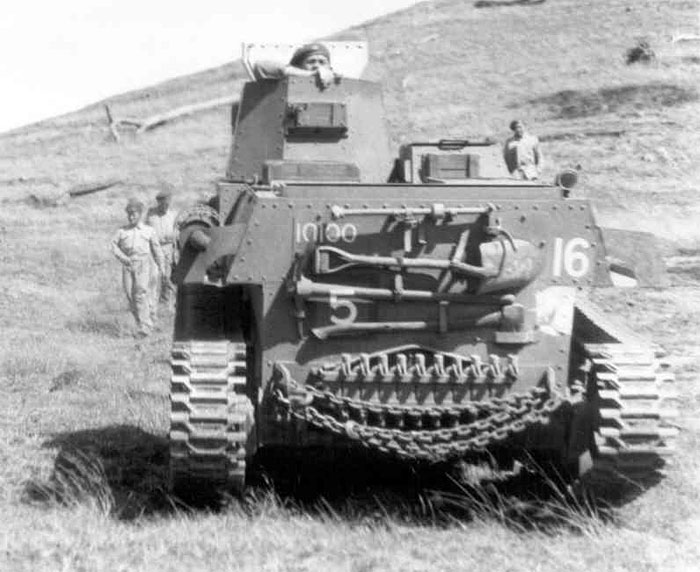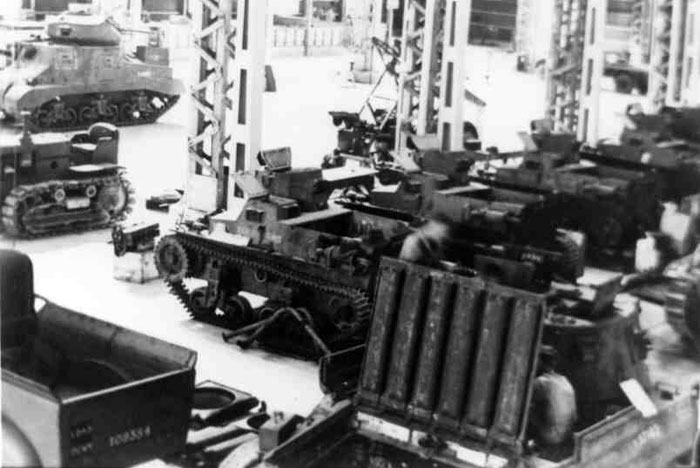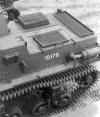|
Marmon Herrington Tanks in Australia
by Paul D. Handel
IntroductionWhen the Japanese launched their Pacific campaign in December 1941, all of the countries targeted were unprepared or had only recently begun to arm. As a result of the lightning advances made by the Japanese, many countries were quickly overrun and the military equipment en route from Europe and North America was diverted to locations not yet in the grip of the Japanese empire. Thus, the Australian Government received an unexpected shipment of armoured vehicles from the USA, which had been originally destined for the Netherlands East Indies. These tanks were variously known in Australian documentation as:
DescriptionThe tanks were actually Marmon Herrington Type CTLS-4TAC or 4TA. The US Army designation for this vehicle was T16, but as far as can be ascertained this designation was never used in Australia. The vehicles were built by the Marmon Herrington Company of Indiana. The tank was of conventional design , having the engine, a Hercules 6 cylinder petrol engine, at the rear and a fighting compartment with octagonal turret which mounted a .30 inch Colt machine gun. The weapons were described in an Army Report late in 1942 as “Browning type .30 MG manufactured commercially by Colt and known as MG 38 BT Tank Model “. The turret was offset to either the right or left side of the vehicle. The driver’s compartment was located alongside the turret. A mount in the driver's compartment could also be fitted with a machine gun. The hull and turret were of bolted construction with the maximum armour thickness being 12 mm. The turret had a restricted traverse of 270 degrees. The vehicles were designed to operate in pairs, hence the turret offset.
The front driving sprocket was high mounted, as was the rear idler. Two bogie units, each of the vertical volute spring design and mounting two bogie wheels were mounted on each side of the hull. Each bogie unit mounted a track skid on the top and a single return roller was mounted between the bogie units on the hull. A single exhaust muffler was mounted on the trackguard on the left rear of the vehicle and pioneer tools were stowed in a rack on the rear hull plate. Provision for mounting spare track links was made on both the front and rear lower hull plates. Technical details of the vehicles are as follows: Length 11 ft 10 ins Engine Hercules 6 cylinder Petrol developing 118 bhp at 3500 rpm Width 6 ft 11 1/2 ins Height 6 ft 11 ins Weight 8 1/2 tons Speed 30 mph Crew 2
Issues to the Australian ArmyOn 20 April 1942 Headquarters 1st Australian Armoured Division reported that each of the three regiments of its 2nd Armoured Brigade, then located at Puckapunyal, had been issued with eight Two Man Tanks and requested that as 24 tanks had arrived in Sydney that the same allocation of tanks be made to the three armoured regiments of the 1st Armoured Brigade. On 24 April the division was advised that 20 tanks were to be issued, with the 5th and 7th Armoured Regiments receiving eight tanks and the 6th Armoured Regiment receiving four only. It was advised at the time that these tanks were “NOT part of the normal regimental equipment but purely for driving practice.
The overall Australian position was noted in the Tank Progress Report dated 25 April 1942 , which said "that 102 2 Man Tanks were received, being diverted from Java". The Tank Progress Report dated 7 May 1942 noted a "further 47 Tanks had been received, ex- refugee ships". The total of 149 remained constant until 21 May 1942, when 8 tanks which had been damaged by salt water whilst in transit were stripped and used as spare parts. The subject of spares was raised in Australian circles on a regular basis, but it appears that with the second shipment of tanks there was an amount of spares which could be used for immediate needs. Some 279 Machine Guns for the tanks also were available, with only 36 being issued . Initially the distribution within the Australian Army was:
Use in AustraliaIn June 1942 successful tests of Laryngaphones for two-way communication in the Marmon Herrington Tanks were carried out at the Directorate of AFV Production located at Fishermans Bend near Melbourne. These inter-communication devices were obtained from the Royal Australian Air Force. It is not known if the tanks were subsequently fitted with these items. Late in August 1942, tentative arrangements were made to send 18 Marmon-Herrington 2- Man Tanks north to provide aerodrome protection in Cape York Peninsula. Some at least arrived in the north as they were listed in the strength returns of several units, including Torres Force. The 2nd Australian Tank Battalion were equipped with these vehicles for a time from mid-1942, and used them for training around the Greta -Singleton area of New South Wales. Early in October 1942 orders were given for three Two-Man Tanks to be cannibalised to provide spare parts, thus reducing the total number of tanks available for use to 138.
It would appear that all vehicles were withdrawn from issue in the first half of 1943 and concentrated in Ordnance Vehicle Parks. In November 1943, the vehicles were declared obsolete for use in Australian service and were handed over to the Ford Motor Company of Geelong, Victoria, in December where they were dismantled. The armour plate was used in Australian-made landing craft, and the engines would also be used in water craft. From available reports and recollections of people associated with the vehicles, the quality of workmanship of the vehicles was considered to be high and the engine was good, however the fighting value of the vehicles was thought to be poor. The tanks in service were usually painted only one colour, with white registered numbers often appearing on the hull sides or rear. Numbers were generally in the 10000 series with 10030,10074, 10075, 10077, 10100, 10160, 10170 and 10178 being identified. A tare (weight) of 81/2 tons also appeared on the hull sides. Some photographed in training carried unit and formation signs.
A MysteryAn interesting discovery which helps to cloud the story of the Marmon Herrington Tanks in Australia is the appearance in a photo, taken inside the workshop of the Directorate of AFV Production in 1942, of a Marmon-Herrington TBS series Tractor. This is a small tracked tractor, open topped, used for towing trailers or artillery pieces. The vehicle is not mentioned in any Australian documentation of the period, and appears only in that one photo. Was this vehicle the only one of its type to arrive in Australia? Was a quantity of these tractors brought to Australia, and if so were they in addition to the Marmon-Herrington Tanks or were they included in the total? One has to remember that in the period February to July 1942, it was likely that Japanese attacks on the Australian mainland would increase, and the possibility of invasion was considered real, so the situation was far from stable. This probably contributes to the paucity of records relating to the Marmon -Herrington series, and the fact that ships with "refugee" cargo were docking at Australian ports all the time, and their unknown cargoes discharged into an already overloaded supply system.
ConclusionThe Australian use of the Marmon Herrington Tanks was very limited, and only then due to severe shortages of armoured vehicles in the country. However should a Japanese invasion of the Australian mainland been made, anything capable of being used to fight the invader would have been needed.
AcknowledgementsThe basis of this article first appeared in Museum Ordnance dated November 1994. This article has been updated as additional information became available. Thanks are extended to Laurie Wright, Hanno Spoelstra, Jacques Jost and Don Chew for their assistance during my original research into this subject.
Marmon Herrington Tanks in Australia Photo AlbumClick
the thumbnails in the table below to view the images full size.
Article Text Copyright ©
2005 by Paul D.
Handel Back to Anzac Steel Main Page |






